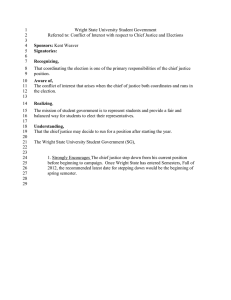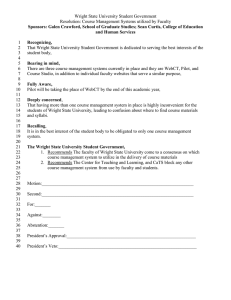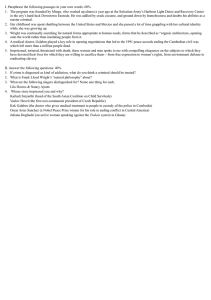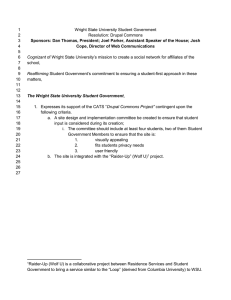CURRICULUM VITAE Charles E. (Ted) Wright Addresses Work
advertisement
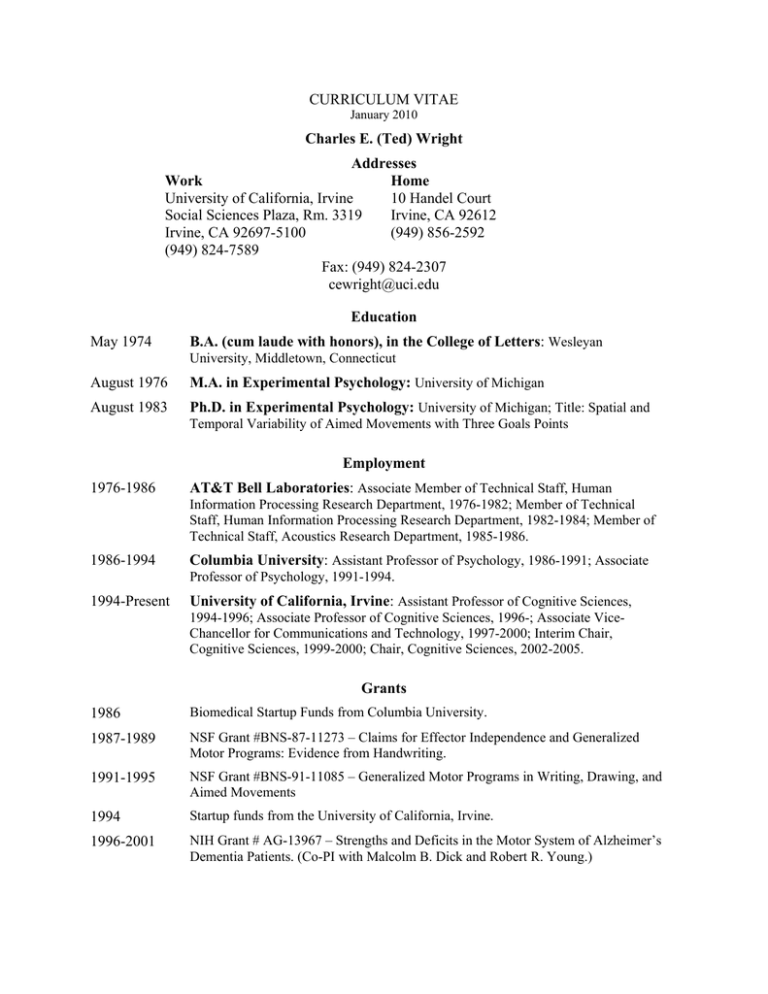
CURRICULUM VITAE January 2010 Charles E. (Ted) Wright Addresses Work Home University of California, Irvine 10 Handel Court Social Sciences Plaza, Rm. 3319 Irvine, CA 92612 Irvine, CA 92697-5100 (949) 856-2592 (949) 824-7589 Fax: (949) 824-2307 cewright@uci.edu Education May 1974 B.A. (cum laude with honors), in the College of Letters: Wesleyan University, Middletown, Connecticut August 1976 M.A. in Experimental Psychology: University of Michigan August 1983 Ph.D. in Experimental Psychology: University of Michigan; Title: Spatial and Temporal Variability of Aimed Movements with Three Goals Points Employment 1976-1986 AT&T Bell Laboratories: Associate Member of Technical Staff, Human Information Processing Research Department, 1976-1982; Member of Technical Staff, Human Information Processing Research Department, 1982-1984; Member of Technical Staff, Acoustics Research Department, 1985-1986. 1986-1994 Columbia University: Assistant Professor of Psychology, 1986-1991; Associate Professor of Psychology, 1991-1994. 1994-Present University of California, Irvine: Assistant Professor of Cognitive Sciences, 1994-1996; Associate Professor of Cognitive Sciences, 1996-; Associate ViceChancellor for Communications and Technology, 1997-2000; Interim Chair, Cognitive Sciences, 1999-2000; Chair, Cognitive Sciences, 2002-2005. Grants 1986 Biomedical Startup Funds from Columbia University. 1987-1989 NSF Grant #BNS-87-11273 – Claims for Effector Independence and Generalized Motor Programs: Evidence from Handwriting. 1991-1995 NSF Grant #BNS-91-11085 – Generalized Motor Programs in Writing, Drawing, and Aimed Movements 1994 Startup funds from the University of California, Irvine. 1996-2001 NIH Grant # AG-13967 – Strengths and Deficits in the Motor System of Alzheimer’s Dementia Patients. (Co-PI with Malcolm B. Dick and Robert R. Young.) 1996-1998 NSF Grant # SBR-9601140 – Modeling Speed-Accuracy Tradeoffs of Aimed Movements. (Co-PI with Rebecca A. States.) 1997-1999 NSF Grant # DBI9724595 – Acquisition of equipment for a Virtual reality laboratory for vision, visuomotor coordination, and synthetic environment research. (Co-PI with Mike D’Zmura and two others.) 2001-2002 CORCLR Multi-investigator award, UCI – Assessing the properties of the dorsal visual stream: Initial experiments on color sensitivity. 2004-2009 NIH Grant #2R01HD013249-25 – Language, Modality, and the Brain. (PI is Karen Emmory of the Salk Institute.) 2010 Special Research Grant, UCI Academic Senate Council on Research, Computing and Libraries Ph.D. Students Supervised Geoffrey L. Collier: Columbia University, 1990; Associate Professor, South Carolina State University. Rebecca States: Columbia University, 1994; Associate Professor, Long Island University. Susie Hsieh: UCI, 2000; Consulting Scientist, Alzheimer's Disease Research Center, UCI. Jennifer Nolan: UCI, 2000; Assistant Professor, Loyola Marymount University; Currently a gerontologist on the staff of Advanced Recovery Rehabilitation Center, Thousand Oaks, CA. Valerie Marino: UCI 2008; Lecturer Loyola Marymount University. Sien Hu: UCI 2009: Post-doc Yale Univeristy medical School Current Ph.D. Students Alissa Winkler Teaching Experience (asterisks mark courses taught at the University of California, Irvine) *1/f Noise in Human Performance (Graduate seminar) *Cognitive Science *Dynamic Systems as Models of Cognitive Processes (Graduate Seminar) *Experimental Design and Data Analysis (Required graduate course) Hierarchy as an Organizing Principle for Action (Graduate seminar) Human Information Processing *Introduction to Psychology (Memory, Thinking, Language, Social and Cognitive Development) *Mental Modules, Inferring the Organization of (Graduate Seminar) *MatLab Programming for Psychophysical Experiments (Graduate Seminar) *MEL Programming Models of Trajectory Formation in Aimed Movements (Graduate seminar) *Nature and Acquisition of Skill in Human Performance (Upper-level seminar) Parallel Distributed Processing Models of Human Behavior (Graduate seminar) Wright: 2 of 11 Psychology of Human-Computer Interaction *Quantitative and Statistical Modeling (Required graduate course) Relation of Syntax and Prosody in Speech (Graduate seminar) *Psychological Research Methods *Planning and Teaching an Introductory Psychology Course (Graduate seminar) *Visual-Motor Interactions (Graduate seminar) Membership in Professional Societies American Psychological Association American Psychological Society International Graphonomics Association Psychonomic Society Other Professional Activities Consulting editor for the Journal of Motor Behavior (1984-1990). Member of the site visit team to Haskins Laboratories for the National Institutes of Health Review Committee on Communicative Disorders (1984). Consultant to Black and Decker, Inc. on movement issues related to product liability law suits (1989-1995). Member of the Advisory Council for the International Association for The Study of Attention and Performance (1996-2003). Panel member, NSF Perception, Action, and Cognition Panel (2005-2006) Member of the editorial board for American Journal of Psychology (2008 - ) Memober of the editorial board for Attention, Perception & Psychophysics (2008 - ) Ad hoc reviewer for Acta Psychologica Journal of Experimental Psychology: Human Perception and Performance Journal of Neurophysiology Journal of Vision Pattern Recognition Perception and Psychophysics Psychonomic Bulletin and Review Psychological Review Psychological Science Quarterly Journal of Experimental Psychology Vision Research Journal Articles and Book Chapters [1] Seamon, J. G. & Wright, C. E. (1976) Generative processes in character classification: Evidence for a probe encoding set. Memory and Cognition, 4, 96-102. [2] Sternberg, S., Monsell, S., Knoll, R. L., & Wright, C. E. (1978) The latency and duration of rapid movement sequences: Comparisons of speech and typing. In G. E. Stelmach (Ed.), Information processing in motor control and learning (Chap. 6, pp. 118 - 152). New York: Wright: 3 of 11 Academic Press. Reprinted in R. A. Cole (Ed.), Perception and production of fluent speech (Chap. 15, pp. 469-505). Hillsdale, NJ: Lawrence Erlbaum Associates, 1980. [3] Sternberg, S., Knoll, R. L. & Wright, C. E. (1978) Experiments on temporal aspects of keyboard entry. In J. P. Duncanson (Ed.), Getting it together: Research and applications in human factors. Santa Monica: Human Factors Society. [4] Wright, C. E. (1979) Duration differences between rare and common words and their implications for the interpretation of word frequency effects. Memory and Cognition, 7, 411-419. [5] Sternberg, S., Wright, C. E., Knoll, R. L., & Monsell, S. (1982) Motor programs in rapid speech: Additional evidence. In R. A. Cole (Ed.), Perception and production of fluent speech (Chapter 16, pp. 507-534). Hillsdale, NJ: Lawrence Erlbaum Associates. [6] Derr, M. A., Wright, C. E., & Coriell, A. S. (1982) A Satellite System for Controlling Real-Time Experiments. Behavioral Research Methods and Instrumentation, 14, 264-271. [7] Meyer, D. E., Smith, J. E. K., & Wright, C. E. (1982) Relations between the speed and accuracy of aimed limb movements. Psychological Review, 82, 449-482. [8] Wright, C. E. & Meyer, D. E. (1983) Sources of the linear speed-accuracy tradeoff in aimed limb movements. Quarterly Journal of Experimental Psychology, 35A, 279-296. [9] Wright, C. E. (1983) Spatial and temporal variability of aimed movements with three contrasting goal points. Doctoral dissertation, University of Michigan. [10] Sternberg, S., Wright, C. E., & Knoll, R. L. (1985) Analysis of action. Contemporary Psychology, 30, 10-12. [11] Meyer, D. E., Abrams, R. A., Kornblum, S., Wright, C. E., and Smith, J. E. K. (1988) Optimality in Human Motor Performance: Ideal Control of Rapid Aimed Movements. Psychological Review, 95, 340-370. [12] Sternberg, S., Knoll, R. L., Monsell, S., & Wright, C. E. (1989) Motor programs and hierarchical organization in the control of rapid speech. Phonetica, 45, 175-197. [13] Meyer, D. E., Smith, J. E. K., Kornblum, S., Abrams, R. A., Wright, C. E. (1990) Speedaccuracy tradeoffs in aimed movements: Toward a theory of rapid voluntary action. In M. Jeannerod (Ed.), Attention and Performance XIII: Motor Representation and Control (Chapter 6, pp. 173-226).Hillsdale, NJ: Lawrence Erlbaum. [14] Wright, C. E. (1990) Generalized motor programs: Reevaluating claims of effector independence. In M. Jeannerod (Ed.), Attention and Performance XIII: Motor Representation and Control (Chapter 9, pp. 294-320). Hillsdale, NJ: Lawrence Erlbaum. [15] Wright, C. E. (1990) Controlling sequential motor activity. In Osherson, D., Kosslyn, S. M., & Hollerbach, J. M. (Eds.), Invitation to Cognitive Science: Visual Cognition and Action, Volume 2 (Chapter 5, pp. 285-316). Cambridge, MA: MIT Press. [16] Wright, C. E. (1991) Temporal Invariance in Writing. In Stelmach, G. E. (Ed.), Motor Control of Handwriting (pp. 86-89). Nijmegan, The Netherlands: International Graphonomics Society. Wright: 4 of 11 [17] Wright, C. E. (1993) Evaluating the special role of time in the control of writing. Acta Psychologica, 82, 5-52. [18] Collier, G. L. & Wright C. E. (1995) Generalized motor programs, temporal rescaling, and simple rhythmic performance. Journal of Experimental Psychology: Human Perception and Performance, 21, 602-627. [19] Wright, C. E. & States, R. A. (1995) Biological variability and control of movements via delta-lambda. Behavioral and Brain Sciences, 18, 786-786. [20] Wright, C. E. & Lindemann, P. G. (1995) Generalization of motor representations for handwriting: What is learned when learning to write with the non-dominant hand. In Simner, Marvin L. (Ed.), Basic and Applied Issues in Handwriting and Drawing Research, (pp. 170-171). Nijmegan, The Netherlands: International Graphonomics Society. [21] Wright, C. E. & Meyer, D. E. (1997) The Delta-Lambda Model: "Yes" for Simple Movements Trajectories; "No" for Speed-Accuracy Tradeoffs. Behavioral and Brain Sciences, 20, 324-325. [22] Lindemann, P. G. & Wright, C. E. (1998) Skill acquisition and plans for actions: Learning to write with your other hand. In Scarborough, D. & Sternberg, S. (Eds.), Invitation to Cognitive Science, vol. 4 (pp. 523-584). Boston, MA: MIT Press. [23] Wright, C. E. & Landau, B. (1998) Language and action: Current challenges. In J. Hochberg (Ed.), Handbook of perception and cognition. Perception and cognition at century's end: History, philosophy, theory. Orlando, FL: Academic Press (pp. 373-402). [24] Wright, C. E., Lindemann, P. G., & Dick, M. C. (1999) Using handwriting to assess fine motor control in Alzheimer's disease. In Leedham, G., Leung, M., Sagar, V., and Xuhong, X. (Eds.), Proceedings of the 9th Biennial Conference of the International Graphonomics Society (pp. 213 - 217). Nijmegan, The Netherlands: International Graphonomics Society. [25] Wright, C. E., Hsieh, S., & Dick, M. B. (1999) Effects of Alzheimer's disease on basic drawing processes. In Leedham, G., Leung, M., Sagar, V., and Xuhong, X. (Eds.), Proceedings of the 9th Biennial Conference of the International Graphonomics Society (pp.219 - 223). Nijmegan, The Netherlands: International Graphonomics Society. [26] States, R. A. & Wright, C. E. (2001). The interplay of biomechanical constraints and kinematic strategies in selecting arm postures. Journal of Motor Behavior, 33, 165-179. [27] Nolan, J. H. & Wright, C. E. (2001). Evidence of impaired glucose tolerance and insulin resistance in Alzheimer's disease patients. Current Directions in Psychological Science, 10, 102-105. [28] Bosworth, R.G., Wright, C.E., Bartlett, M.S., Corina, D.P., & Dobkins, K.R. (2003). Characterization of the visual properties of signs in ASL. In A. E. Baker, B. van den Bogaerde & O. Crasborn (Eds), Cross-linguistic perspectives in sign language research. Selected papers from TISLR 2000 (pp. 265-282). Hamburg: Signum Press. [29] Wright, C. E. & Chubb, C. (2004). Planning differences for chromaticity- and luminancedefined stimuli: A possible problem for Glover's planning-control model. Behavioral and Brain Sciences, 27, 55. Wright: 5 of 11 [30] Wright, C. E. (2007). Editorial contributor for the (200+) entries related to motor control, in Gary R. VandenBos (Ed.), APA Dictionary of Psychology. Washington, DC: American Psychological Association. [31] Wright, C. E., Marino, V. F., Belovsky, S. A, & Chubb, C. (2007). Visually-guided, aimed movements can be unaffected by stimulus-response uncertainty. Experimental Brain Research, 179, 475-496. [32] Emmorey, K., Gertsberg, N., Korpics, F., & Wright, C.E. (2009). The influence of visual feedback and register changes on sign language production: A kinematic study with deaf signers. Applied Psycholinguistics, 30, 187-203. [33] Nam, J.-H., Solomon, J. A., Morgan, M. J., Wright, C. E., and Chubb, C. (2009). Coherent plaids are preattentively more than the sum of their parts. Attention, Perception & Psychophysics, 71 1469-1477. Technical Reports: AT&T Bell Laboratories [1] Sternberg, S., Knoll, R. L., Wright, C. E., and Monsell, S. (1982) Control of rapid action sequences in speech and typewriting. AT&T Bell Laboratories Technical Memorandum. [2] Derr, M. A. and Wright, C. E. (1982) Users' manual for the PARASITE-FS system. AT&T Bell Laboratories Technical Memorandum. [3] Derr, M. A. and Wright, C. E. (1982) Guide to the user library for the PARASITE-FS system. AT&T Bell Laboratories Technical Memorandum. [4] Derr, M. A. and Wright, C. E. (1982) Guide to the visual display package for the PARASITE-FS system. AT&T Bell Laboratories Technical Memorandum. [5] Derr, M. A. and Wright, C. E. (1982) Guide to the PARASITE-FS file system and the ELF monitor. AT&T Bell Laboratories Technical Memorandum. [6] Wright, C. E. and Derr, M. A. (1982) The PARASITE-FS system: New ideas for a satellite system for controlling real-time experiments. AT&T Bell Laboratories Technical Memorandum. [7] Altom, M. J. and Wright, C. E. (1984) Routines for input of information to experiment programs. AT&T Bell Laboratories Technical Memorandum. [8] Boie, R. A., Mathews, M. V., Nakatani, L. H., and Wright, C. E. (1984) Acoustic sensor to control the pointer on a computer terminal. AT&T Bell Laboratories Technical Memorandum. [9] Liberman, M. Y., Wright, C. E., and Gelbard, J. D. (1984) Datakit lore. AT&T Bell Laboratories Technical Memorandum. [10] Turock, D. L. and Wright, C. E. (1985) An optimized and extended tapply function for S. AT&T Bell Laboratories Technical Memorandum. [11] Wright, C. E., Bachenko, J. and Fitzpatrick, E. (1986) An experimental system using syntax to generate prosody for the Bell Labs text-to-speech system. AT&T Bell Laboratories Technical Memorandum. Wright: 6 of 11 [12] Wright, C.E., Martin, M. C., Altom, M. J., and Olive, J. P. (1986) Formant transitions as a cue to voicing in post-vocalic stop consonants. AT&T Bell Laboratories Technical Memorandum. [13] Wright, C. E. (1988) Evaluation of synthetic speech: an overview and several proposals. AT&T Bell Laboratories Technical Memorandum. Invited Addresses Wright, C. E. (1991) Temporal Invariance in Writing. Invited address at the Fifth Handwriting Conference of the International Graphonomics Society, IGS. Tempe, Arizona: October 1991. Meeting Papers [1] Seamon, J. G. & Wright, C. E. (1975) Rehearsal as a generative process in memory scanning. American Psychological Association, Chicago. [2] Wright, C. E. & Pachella, R. G. (1976) Rehearsal controlled stimulus expectancy in the Sternberg task: Evidence for a mechanism that bypasses memory scanning. Midwestern Psychological Association, Chicago. [3] Meyer, D. E., Sternberg, S., Knoll, R. L., & Wright, C. E. (1978) Memory retrieval and motor programming of related-word sequences. Paper presented at the Midwestern Psychological Association meeting. [4] Sternberg, S., Knoll, R. L., & Wright, C. E. (1978) The timing of rapid movement sequences in typewriting. Paper presented at the Psychonomic Society Meeting. [5] Sternberg, S., Wright, C. E., & Knoll, R. L. (1980) The role of lexical memory in rapid speech production. Psychonomic Society, Phoenix, Arizona. [6] Derr, M. A., Wright, C. E., & Coriell, A. S. (1981) A satellite system for controlling realtime experiments. National Conference on the Use of On-line Computers in Psychology, Philadelphia. [7] Sternberg, S., Knoll, R. L., Wright, C. E., and Monsell, S.(1982) Control of rapid action sequences in speech and typewriting. Psychonomic Society Meeting. [8] Knoll, R. L., Sternberg, S., & Wright, C. E. (1982) Two-stroke units: Evidence for a retrieval model in typing. Paper presented at the Psychonomic Society Meeting. [9] Wright, C. E., Meyer, D. E., & Smith, J. E. K. (1982) Models for the speed and accuracy of aimed limb movements. 15th Annual Mathematical Psychology Meeting, Princeton University, Princeton, NJ. [10] Sternberg, S., Knoll, R. L., Monsell, S., & Wright, C.E. (1983) Control of rapid action sequences in speech and typing. Invited address by S. Sternberg, American Psychological Association Meeting. [11] Abrams, R. A., Kornblum, S., Meyer, D. E., & Wright, C. E. (1983) Fitts' law: Optimization of initial ballistic impulses for aimed movements. Paper presented at the Annual Meeting of the Psychonomic Society, San Diego, California. [12] Wright, C. E. (1983) Spatial variability of movements to three contrasting goal points. Paper presented at the Annual Meeting of the Psychonomic Society, San Diego, California. Wright: 7 of 11 [13] Bachenko, J., Fitzpatrick, E., and Wright, C. E. (1986) The contribution of parsing to prosodic phrasing in an experimental text-to-speech system. 24th Annual Meeting of the Association for Computational Linguistics, New York, June 1986. [14] Monsell, S., Sternberg, S., Knoll, R. L., and Wright, C. E. (1986) Motor programming in speech and other rapid sequential skills. XXXth Congress of the International Union of Physiological Sciences, Vancouver, Canada, July 1986. [15] Wright, C. E., Altom, M. J., Olive, J. P. (1986) Diagnostic evaluation of a synthesizer's acoustic inventory. Paper presented at the meetings of the Acoustical Society of America. Abstract published in the Journal of the Acoustical Society of America, 79, Supplement 1, p. S25. [16] Meyer, D. E., Smith, J. E. K., Kornblum, S., Abrams, R. A., Wright, C. E. (1988) Speedaccuracy tradeoffs in aimed movements: Toward a theory of rapid voluntary action. Attention and Performance XIII: Motor Representation and Control, Arc-et-Senans, France, June-July 1988. [17] Wright, C. E. (1988) Generalized motor programs: Reevaluating claims of effector independence. Attention and Performance XIII: Motor Representation and Control, Arc-etSenans, France, June-July 1988. [18] Wright, C. E. & Main, A. M. (1989) Selectively searching for conjunctively defined visual targets. Poster presented at the 30th Annual Meeting of the Psychonomic Society, Atlanta, Georgia. [19] Wright, C. E. (1990) Movement-time invariance of writing assessed across changes in size, effector, and instructional emphasis. Poster presented at the 31st Annual Meeting of the Psychonomic Society, New Orleans, Louisiana. [20] Wright, C. E. & States, R. (1992) Joint Angle Determinants in Aimed Arm Movements with Excess Degrees of Freedom. Poster presented at the 33rd Annual Meeting of the Psychonomic Society, St. Louis, MO, November 13-15. [21] States, R. & Wright, C. E. (1993) An Empirical Study of Joint-Level Motor Equivalence at the End-Point of Planar Aimed Arm Movements. Poster presented at the Neurosciences meetings. Society for Neuroscience Abstracts, 19(1), #228.2. [22] Wright, C. E. & Lindemann, P. G. (1993) Effector Independence in HierarchicallyStructured Motor Programs for Handwriting. Paper presented at the 34th Annual Meeting of the Psychonomic Society, Washington, D.C. [23] Wright, C. E. & Collier, G. L. (1994) Temporal rescaling of simple and complex ratios in rhythmic tapping. Paper presented at the 35th Annual Meeting of the Psychonomic Society, St. Louis, MO, November 11-13. [24] States, R.A. & Wright, C.E. (1994) The relative contributions of geometric versus behavioral constraints in resolving joint-level motor equivalence. Poster presented at the Neurosciences meetings. Society for Neuroscience Abstracts, 20(2), #576.11. [25] Wright, C. E. & Lindemann, P. G. (1995) Generalization of motor representations for handwriting: What is learned when learning to write with the non-dominant hand. Paper Wright: 8 of 11 presented at the Seventh Biennial Conference of the International Graphonomics Society, IGS, London, Ontario, Canada, August. [26] Dick, M. B., Young, R. R., Wright, C. E., & Hsieh, S. (1996) Control of motor movements in Alzheimer's Disease. Poster presented at the Forty-Eighth Annual Meeting of the American Academy of Neurology, San Francisco, March. [27] Wright, C. E., Beck, J. R., Chubb, C. (1996) 1/f Noise in Repeated Productions of Spatial Intervals. Paper presented at the 37th Annual Meeting of the Psychonomic Society, Chicago, November 1-3. [28] Dick, M. B., Young, R. R., Wright, C. E., Hsieh, S., & Wagner, A. (1996) Abnormal motor control in patients with Alzheimer's and Parkinson's disease. Poster presented at the 12th international Symposium on Parkinson's Disease, London, March 24. [29] Wright, C. E., Beck, J. R., Chubb, C. (1996) Sources of 1/f Variability in Repeated Judgments and Productions. Paper presented at the Seventh Annual International Conference of The Society for Chaos Theory in Psychology & Life Sciences, Milwaukee, WI, August 1. [30] States, R.A., Wright, C.E., Cissik, J.M., Gorde, H.W. & Alexander, J.K. (1997) Speed accuracy trade-offs for wrist, elbow and shoulder movements. Poster presented at the Meetings of the Society of Neuroscience, New Orleans, October 29. Society of Neuroscience Abstracts, 22. [31] Wright, C. E., Gage, N., & States, R. (1997) Does concurrent visual feedback guide corrective submovements in the Fitts task? Paper presented at the 38th Annual Meeting of the Psychonomic Society, Philadelphia, November 22. [32] Guy, S. C. and Wright, C. E. (1998) The role of visual feedback in kindergartners' acquisition of novel letters. Poster presented at the annual meeting of The Association for Research in Vision and Ophthalmology, Fort Lauderdale, May 14. [33] Wright, C. E., Lindemann, P. G., & Dick, M. C. (1998) Using Handwriting to Assess Fine Motor Control in Alzheimer's Dementia. Poster presented at the 39th Annual Meeting of the Psychonomic Society, Dallas, November 21. [34] States, R. A., Wright, C. E., & Susman, W. (1999) Does Participation by Specific Joints Influence Speed/Accuracy Tradeoffs? Poster presented at the meeting of the American Physical Therapy Association, Section on Research. [35] Hsieh, S., Wright, C. E., & Dick, M. B. (1999) Deficits of Drawing Behavior in Alzheimer's Disease Populations. Poster presented at the meeting of the Cognitive Neuroscience Society, Washington, D.C., April 13. [36] Wright, C. E. & Chubb, C. (1999) Mechanisms used to visually section line segments. Poster presented at the meeting of the Association for Research in Vision and Opthalmology, Ft. Lauderdale, FL, May 10th. [37] Wright, C. E., Hsieh, S., & Dick, M. B. (1999) Effects of Alzheimer's disease on low-level drawing processes. Paper presented at the 9th International Graphonomics Society Conference, Singapore, June 30th. Wright: 9 of 11 [38] Wright, C. E., Lindemann, P. G., & Dick, M. C. (1999) Using Handwriting to Assess Fine Motor Control in Alzheimer's Dementia. Paper presented at the 9th International Graphonomics Society Conference, Singapore, June 30th. [39] Bosworth, R. G., Wright, C. E., Bartlett, M. S., Corina, D. P., & Dobkins, K. R. (2000) Characterization of the Visual Properties of Signs in ASL. Theoretical Issues in Sign Language Research, 7th biannual conference, Amsterdam. [40] States, R. A. & Wright, C. E. (2000) Identifying factors related to effector systems that influence speed-accuracy tradeoffs. Poster presented at the Neurosciences meetings. [41] Wright, C. E. (2000) Developing fluent strokes in writing produced with the nondominant hand. Invited paper presented at the International Workshop on Computational Models in Handwriting. University of Nijmegen, The Netherlands: 28-30 June. [42] Anderson, S. L. & Wright, C. E. (2001) Prior learning and SATs as determinants of movement times embedded in piano performance. Poster presented at the meeting of the Psychonomic Society, New Orleans: November 18. [43] Chubb, C., Wright, C. E., Anderson, S., & Kim, P. (2002) Psychophysical dissociation of how" and "what" tasks in normal participants. Paper presented at the meetings of the Visual Science Society. Fort Lauderdale, FL: April. [44] Wright, C. E., Chubb, C., Anderson, S., & Kim, P. (2002) Color/Luminance Dissociation across "How" and "What" Processing of Normal Participants. Paper presented at the meetings of the Psychonomics Society. Kansas City, KA: November. [45] Belovsky, S. A., Wright, C. E., Marino, V. F., Chubb, C. (2004) Visually-Guided, Aimed Movements are Unaffected by Stimulus-Response Uncertainty. Paper presented at the meetings of the Psychonomics Society. Minneapolis, MN: November. [46] Winkler, A., Wright, C. E., & Chubb, C. (2005) Dissociating the functions of visual pathways using equisalient stimuli. Paper presented at the meetings of the Visual Science Society. Sarasota, FL. [47] Chubb, C. & Wright, C. E. (2005) A regular grid imposes a block metric on visual space. Paper presented at the meetings of the Visual Science Society. Sarasota, FL. [48] Winkler, A., Wright, C. E., Chubb, C. (2005) Color/Luminance dissociations across “how,” “what,” and “where” processing of normal participants: A second look. Paper presented at the meetings of the Psychonomics Society. Toronto, Canada. [49] Emmorey, K., Gertsberg, N., Korpics, F., and Wright, C. E. (2006). Visual feedback during sign language production. Paper presented at the meetings of the Psychonomics Society. Houston, TX. [50] Hu, S. and Wright, C.E. (2006). Transfer of implicitly learned regularities of spatial movement sequences. Poster presented at the meetings of the Psychonomics Society. Houston, TX. [51] Rubin, T., Chubb, C.F., Wright, C.E., Drew, S.A., & Sperling, G. (2007) Spatiotemporal dynamics of the perception of dot displays. Presented at the annual meeting of the Vision Sciences Society, May 9-14, Naples, FL. Wright: 10 of 11 [52] Chubb, C.E. & Wright, C.E. (2007). Diverse Long Range Configural Judgments Use a Single Map of Object Locations. Presented at the annual meeting of the Vision Sciences Society, May 9-14, Naples, FL. [53] Rubin, T., Chubb, C. F., Wright, C. E., Wong, S. A., Sperling, G. (2008). Spatiotemporal dynamics of the perception of dot displays. Presented at the annual meeting of the Vision Sciences Society, Naples, FL. [54] Chubb, C. F. & Wright, C. E. (2008). Diverse long range configural judgments use a single map of object locations. Presented at the annual meeting of the Vision Sciences Society, Naples, FL. [55] Marino, V. F. & Wright, C. E. (2008). Exploring Violations of Hick’s Law for Aimed Hand Movements. Paper presented at the meetings of the Psychonomics Society. Chicago, IL. [56] Hu, S. & Wright, C. E. (2009). Transfer of Motor Movements. Poster presented at the Cognitive Neuroscience Society annual meeting. San Francisco, CA. [57] Bosworth, R. G., Wright, C. E., & Dobkins, K. R. (2010). Analysis of Visual Properties in American Sign Language. TISLR (Theoretical Issues in Sign Language Research Conference) 10. Purdue University. Wright: 11 of 11

